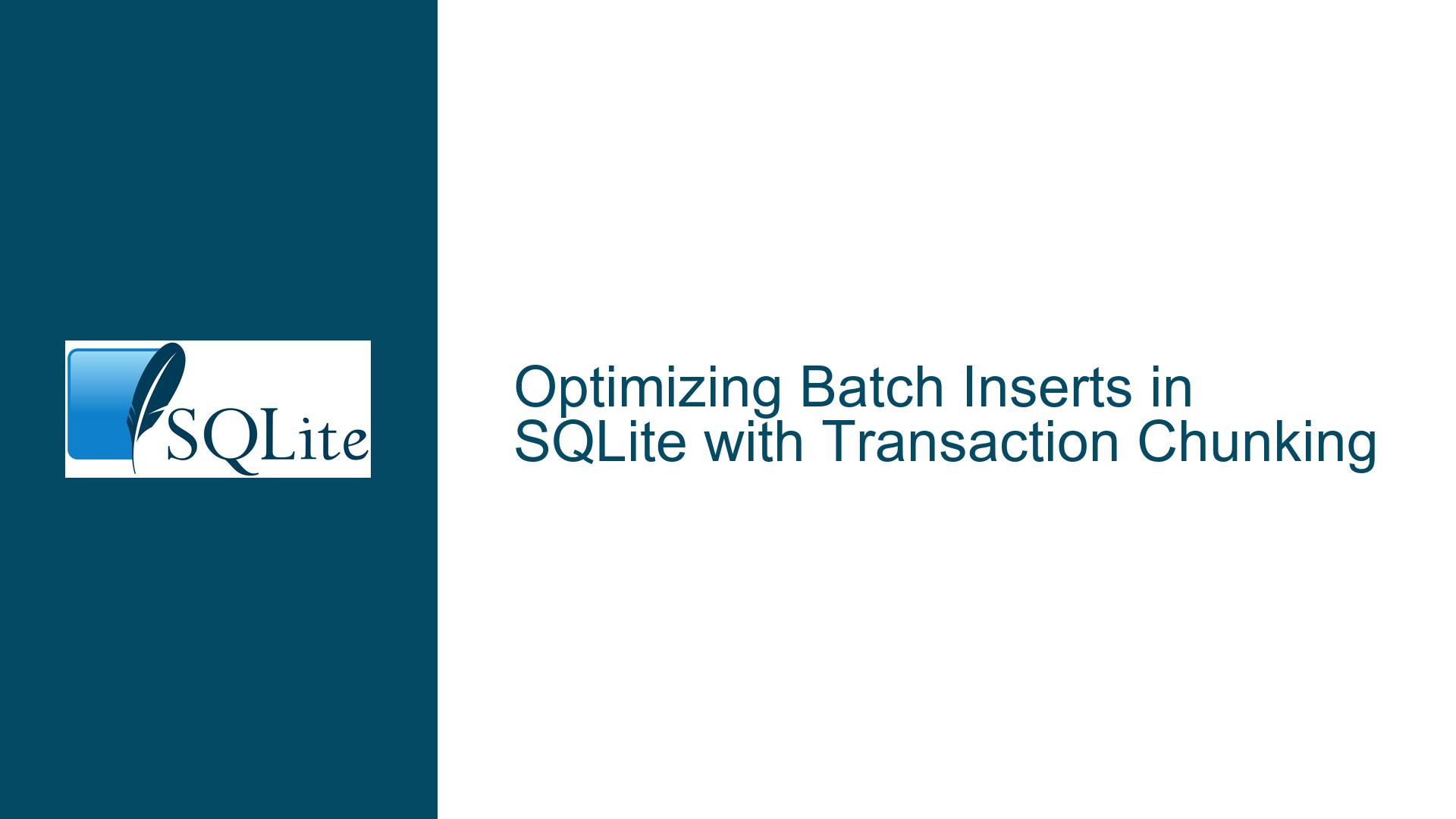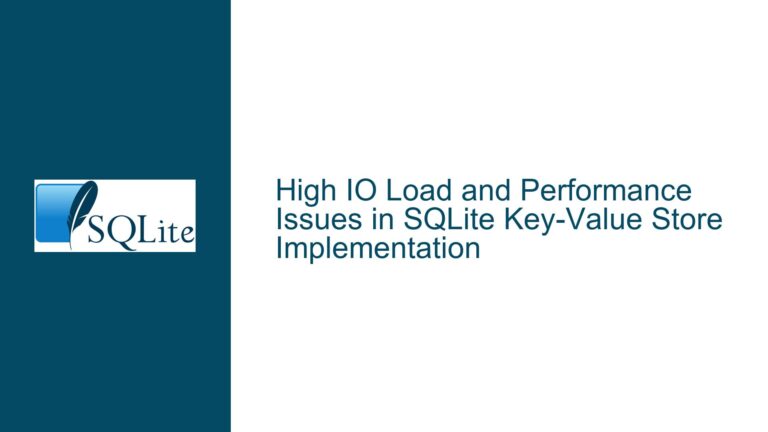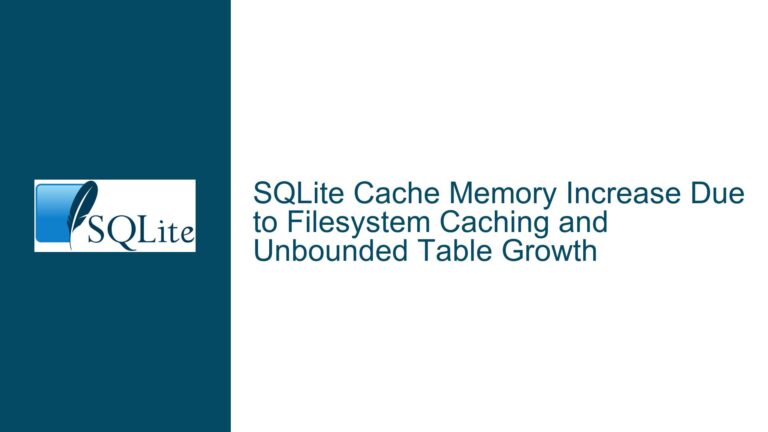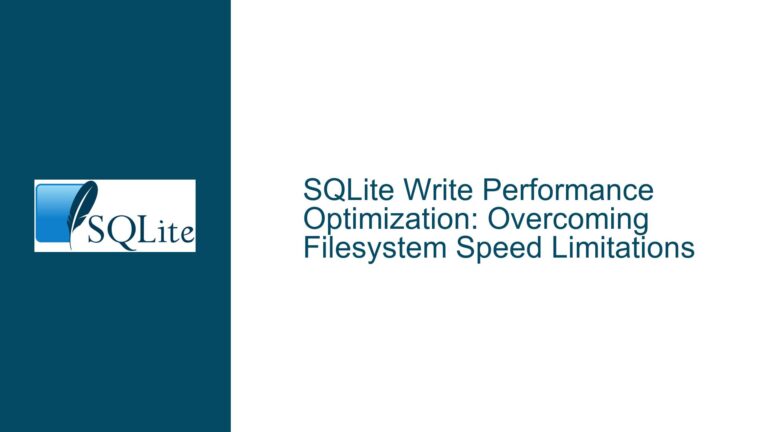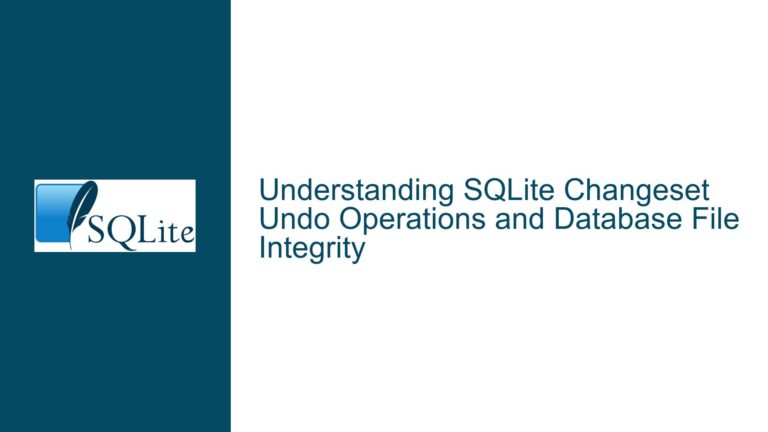Optimizing Batch Inserts in SQLite with Transaction Chunking
Batch Insert Performance Challenges in SQLite
When dealing with large-scale data migrations or batch inserts in SQLite, performance can become a significant concern. The default behavior of SQLite is to treat each INSERT statement as an individual transaction, which can lead to inefficiencies when inserting millions of records. Each transaction incurs overhead due to disk I/O operations, journaling, and locking mechanisms. This overhead becomes particularly noticeable when the data volume is large, as the database engine must repeatedly commit changes to disk, leading to increased latency and reduced throughput.
The core issue arises from SQLite’s transactional model, which ensures data integrity by writing changes to a journal file before committing them to the main database. While this design is excellent for maintaining consistency, it can be a bottleneck for bulk operations. For example, when transferring data from one SQLite database to another using the .mode insert command, the absence of explicit transaction boundaries means that each row is inserted as a separate transaction. This results in unnecessary disk writes and can significantly slow down the process.
Moreover, the lack of a built-in mechanism to automatically chunk large insert operations into smaller transactions forces users to rely on external scripting or manual intervention. This not only complicates the workflow but also limits the accessibility of efficient batch operations to users who may not be familiar with scripting languages like Perl, Python, or shell scripting.
Transaction Overhead and Lack of Built-in Chunking
The primary cause of performance degradation during batch inserts in SQLite is the overhead associated with transactional operations. Each transaction in SQLite involves several steps: acquiring a lock, writing to the journal file, updating the database file, and releasing the lock. When inserting a large number of records, these steps are repeated for every single row, leading to a significant accumulation of overhead.
Another contributing factor is the absence of a built-in feature to automatically divide large insert operations into smaller, more manageable transactions. While SQLite provides tools like the .mode insert command for exporting data, it does not offer a native way to control transaction boundaries during the import process. This limitation forces users to resort to external scripts or manual methods to achieve transaction chunking, which can be error-prone and less efficient.
Additionally, the reliance on external tools introduces compatibility and accessibility issues. Not all environments have access to scripting languages or the ability to execute custom scripts. This creates a barrier for users who need to perform batch inserts but lack the technical expertise or resources to implement workarounds.
Implementing Transaction Chunking with PRAGMA and Scripting
To address the performance challenges associated with batch inserts in SQLite, users can implement transaction chunking using a combination of SQLite’s built-in features and external scripting. The following steps outline a detailed approach to optimizing batch inserts:
Step 1: Understanding PRAGMA journal_mode
SQLite’s PRAGMA journal_mode command allows users to configure the journaling behavior of the database. By setting the journal mode to WAL (Write-Ahead Logging), users can reduce the overhead associated with transactional operations. WAL mode enables concurrent reads and writes, improving performance for bulk operations. However, it is important to note that WAL mode may not be suitable for all environments, particularly those with limited disk space or specific consistency requirements.
Step 2: Manual Transaction Management
For environments where WAL mode is not feasible, manual transaction management can be used to chunk large insert operations into smaller transactions. This involves wrapping a specified number of INSERT statements within BEGIN TRANSACTION and COMMIT TRANSACTION commands. For example, inserting 10,000 records at a time can significantly reduce the number of disk writes and improve overall performance.
Step 3: Leveraging External Scripts
For users who require a more automated solution, external scripts can be used to dynamically generate and execute chunked transactions. The following example demonstrates how to achieve this using a Perl script:
#!/usr/bin/perl
my $nClump = shift;
if (!defined($nClump)) { $nClump = 100; }
print "BEGIN TRANSACTION;\n";
my $nLines = 0;
while ($_ = <>) {
print $_;
if (++$nLines % $nClump == 0) {
print "COMMIT TRANSACTION;\n";
print "BEGIN TRANSACTION;\n";
}
}
print "COMMIT TRANSACTION;\n";
This script reads INSERT statements from standard input and groups them into transactions of a specified size. The script can be executed as part of a data migration pipeline, allowing users to automate the chunking process without modifying the SQLite shell.
Step 4: Combining Techniques for Optimal Performance
For the best results, users can combine the use of PRAGMA journal_mode with manual transaction management or external scripting. For example, enabling WAL mode and chunking inserts into transactions of 10,000 records can provide a significant performance boost. The following table summarizes the key considerations for each approach:
| Technique | Pros | Cons |
|---|---|---|
| PRAGMA journal_mode=WAL | Improves concurrency and reduces overhead | May not be suitable for all environments |
| Manual Transaction Mgmt | Reduces disk I/O and improves performance | Requires manual intervention |
| External Scripting | Automates chunking process | Requires scripting knowledge and tools |
Step 5: Testing and Validation
After implementing transaction chunking, it is essential to test the performance impact and validate the results. Users should monitor metrics such as execution time, disk I/O, and memory usage to ensure that the chosen approach meets their performance requirements. Additionally, it is important to verify data integrity and consistency after the batch insert operation is complete.
By following these steps, users can optimize batch inserts in SQLite and overcome the performance challenges associated with large-scale data migrations. While the lack of a built-in chunking feature may require additional effort, the combination of SQLite’s configuration options and external scripting provides a robust solution for improving efficiency and scalability.
